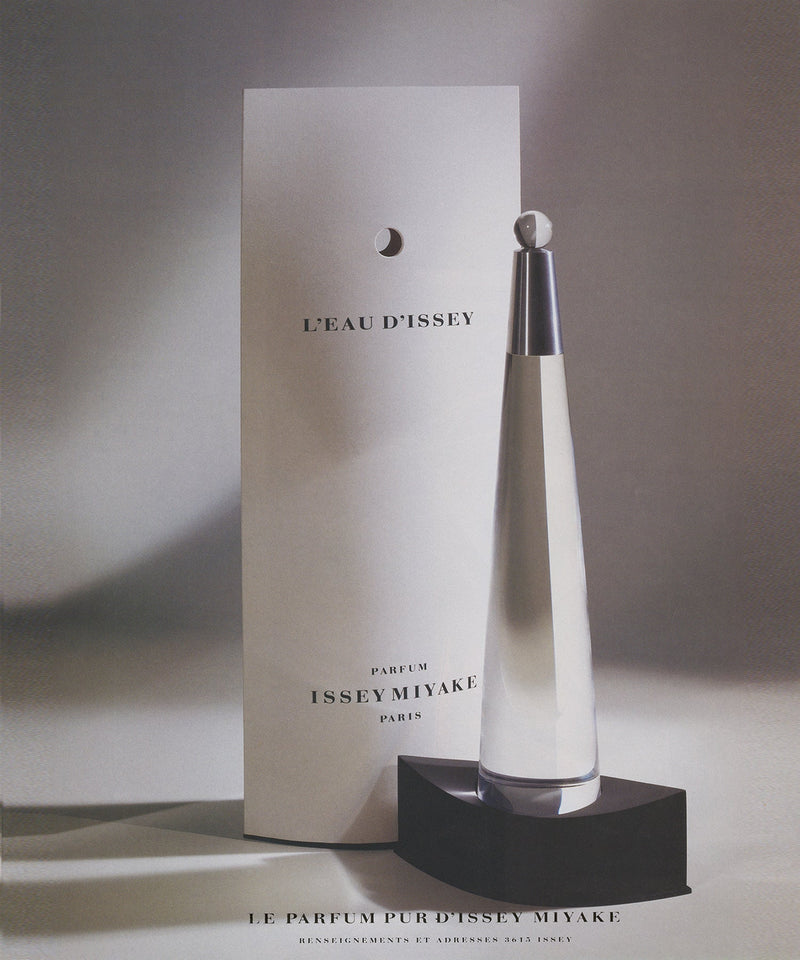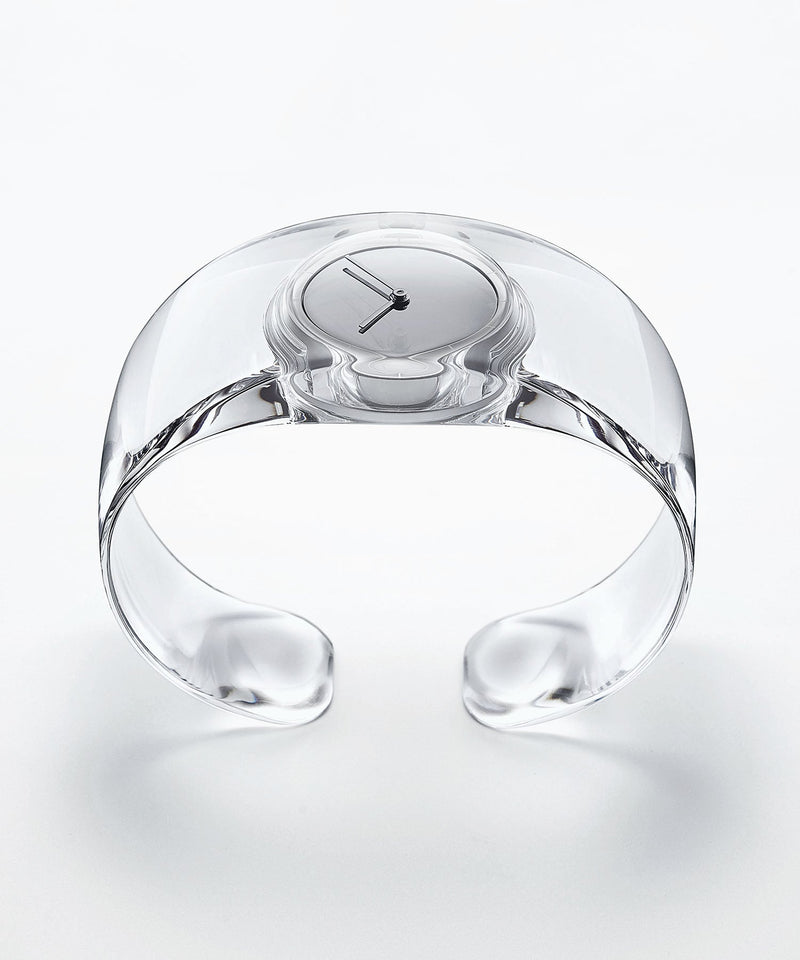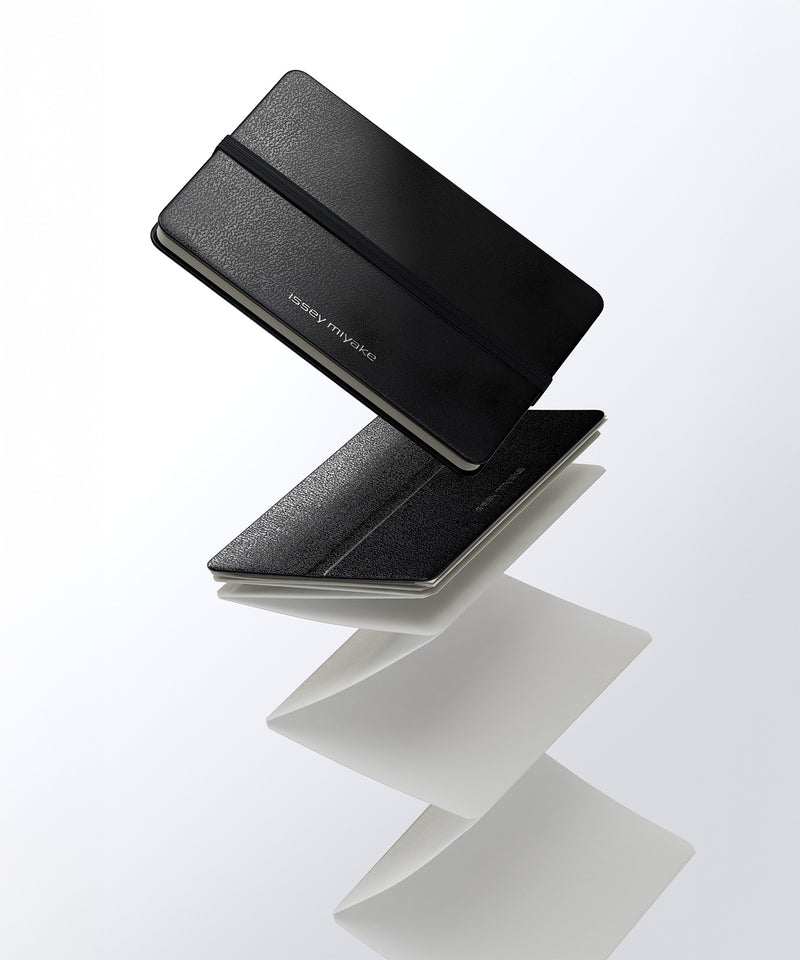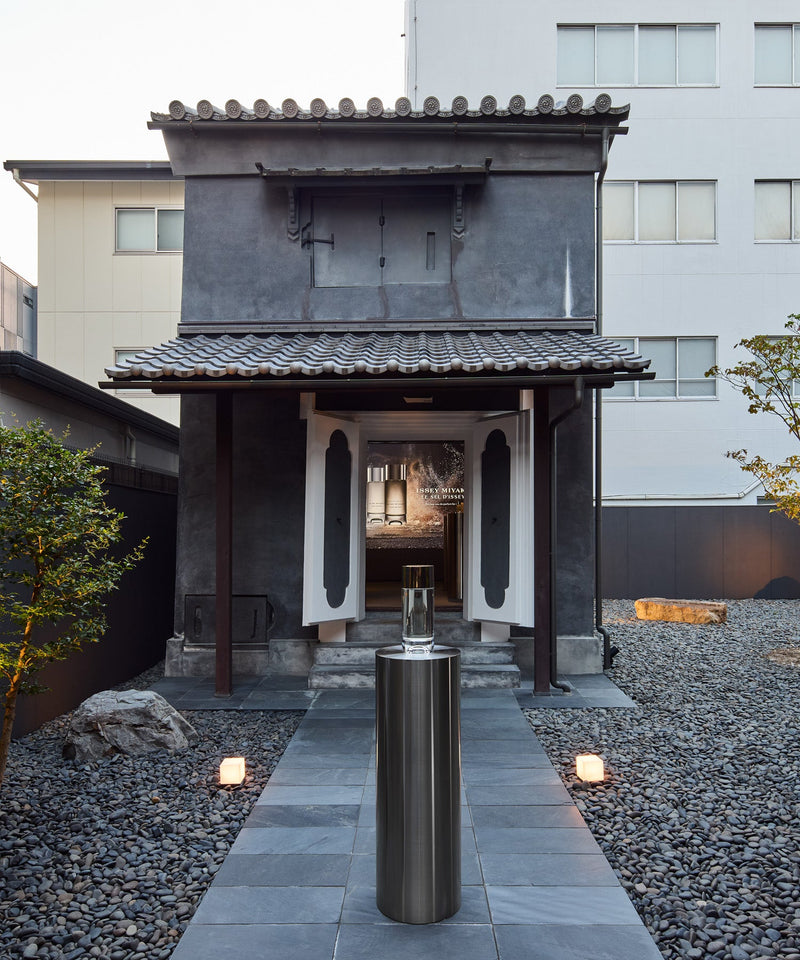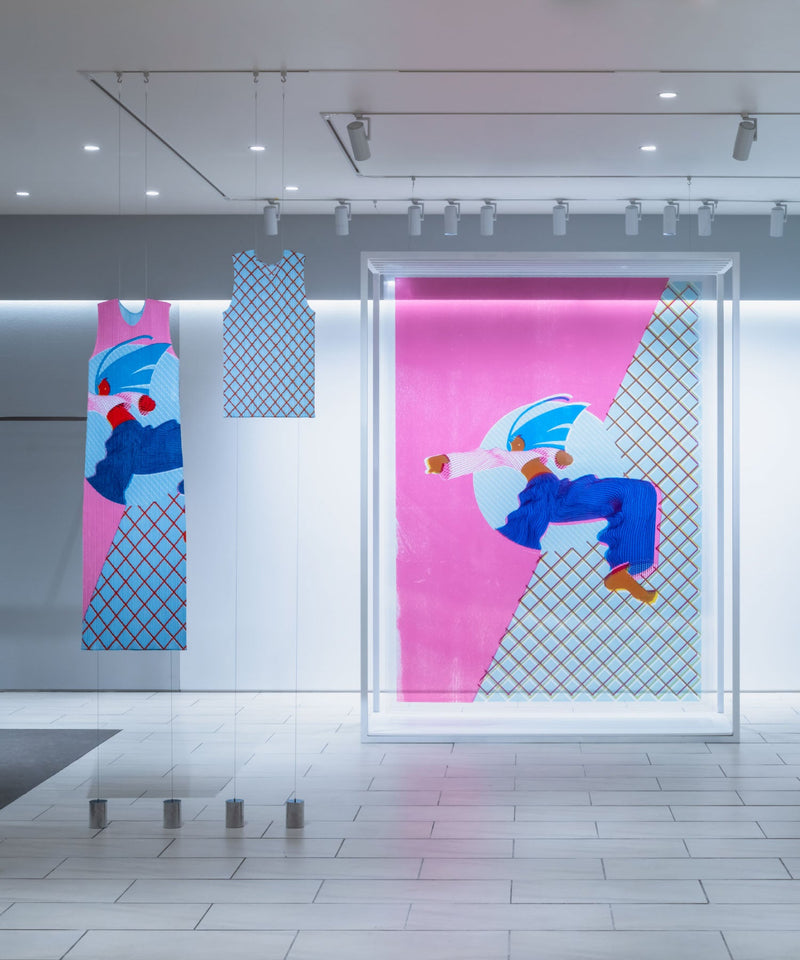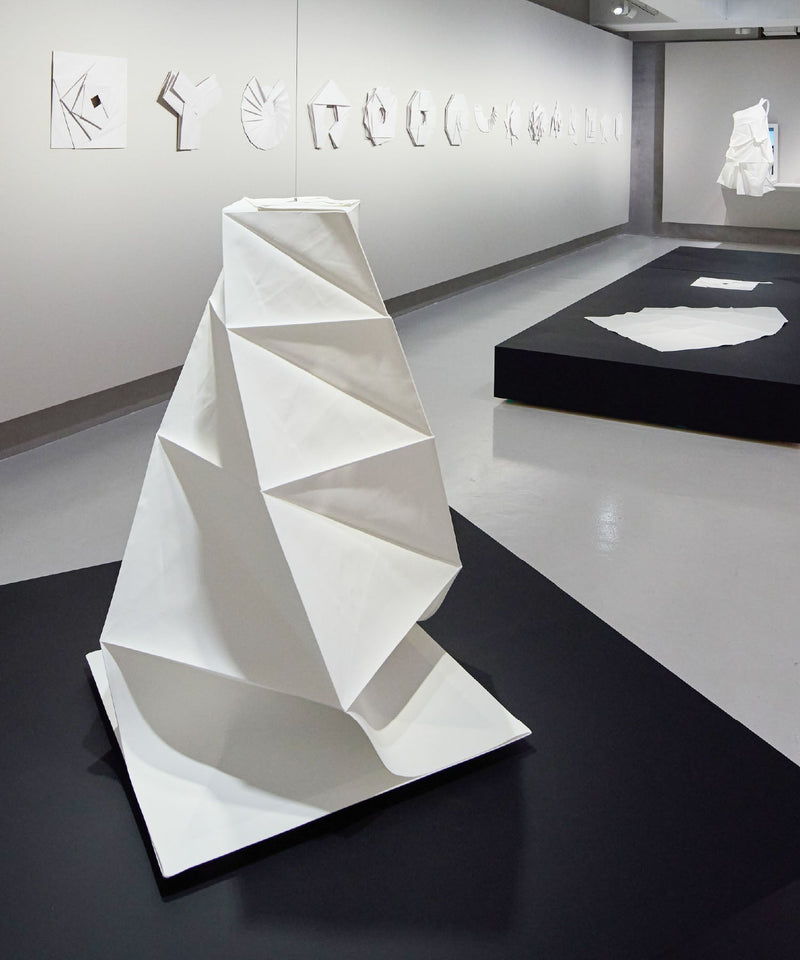Episode 11
2025.10.23
Eugene Kangawa
An Uncharted Language Woven from Light and Shadow

A-POC ABLE ISSEY MIYAKE has announced a new project, “TYPE-XIV Eugene Studio project”, inspired by artist Eugene Kangawa / EUGENE STUDIO and his “Light and shadow inside me” series. In October 2025, during Art Basel Paris, a special exhibition featuring Kangawa and Eugene Studio will be presented in France. This project is an attempt to open new horizons of expression through the intersection of art and clothing. We followed its development through a dialogue with Kangawa himself.

Eugene Kangawa’s “Light and shadow inside me” series. Using sunlight and light, these works embed traces of light and time into material, creating new possibilities of expression beyond painting or photography.
— To begin with, could you tell us how this project first came about? We understand that it began when Miyamae-san visited Kangawa-san’s solo exhibition “EUGENE STUDIO After the rainbow” (Museum of Contemporary Art Tokyo, 2021–22).
Yoshiyuki Miyamae (hereafter, Miyamae): I still remember it vividly. I often make time to visit various exhibitions, but Kangawa-san’s show was one that made me think, “I want to see this again”. What struck me as a curious coincidence was the timing, which happened to be when I had just passed on the role of designer for ISSEY MIYAKE’s collection and began a new venture, A-POC ABLE ISSEY MIYAKE (hereafter, A-POC ABLE). At that moment I was determined to work together with many people to carry forward and evolve what Miyake had built. Then I encountered Kangawa-san’s work, and his ability to grasp the essence of things and express it as beauty that exists beyond words. It moved me profoundly. That experience became the starting point of our relationship as A-POC ABLE with Kangawa-san.

At Eugene Kangawa’s studio.
Eugene Kangawa (hereafter, Kangawa): Thank you. Yes, we spoke about many things after that exhibition, didn’t we? I remember visiting the Issey Miyake office for the first time afterwards, where I was given the large TASCHEN book, ISSEY MIYAKE. It offered me a chance to explore once more the history I thought I already understood, the existence and philosophy that is Issey Miyake. Then the A-POC ABLE team led by Miyamae-san visited my studio and home, and the workshops we held together eventually led to this project.

A workshop with the A-POC ABLE team held at Kangawa’s studio.
Miyamae: In those workshops, we tried a method similar to Kangawa-san’s “Light and shadow inside me” series: folding sheets of self-made cyanotype paper, exposing them to sunlight, and letting subtle shifts in color emerge over time. During this process, we tend to think in terms of structure and function first, just like when creating clothing. But Kangawa-san’s approach centered on the presence of the folded paper itself, as well as on the interplay of light and shadow revealed through fading. A way of perceiving beauty that had never occurred to us before. From there, we began to experiment with two and three dimensions, working with our hands, and engaging with the act of folding as a way to imagine our own sense of beauty. It was a deeply enjoyable experience that expanded our perspective in profound ways.

Experimenting with various folding techniques while imagining fading and color changes caused by sunlight. At Kangawa’s studio.
— Starting with “Light and shadow inside me”, your works often seem to present tangible forms while also containing a sense of abstraction within. How do you think about the movement between two and three dimensions, or between the concrete and the abstract in your work?
Kangawa: In the early years, my mid-teens, I created many figurative drawings and paintings. Compared to those, my recent works may appear more abstract but I feel that the way of seeing, with my “eyes,” has not changed, even if the techniques have.
For me, a work of art is the result of a convergence between individual experience and the time in which we live, a time that reflects our history. Rather than thinking in terms of concrete versus abstract, what matters to me is the existence of “time” itself within the work. For instance, the turquoise-blue paintings in “Light and shadow inside me” were made by folding watercolor paper coated with water-based ink into polygonal forms, fixing them in place, and exposing them to sunlight for several weeks before unfolding them again. And the same technique was used for the monochrome work, which was created by folding a sheet of silver gelatin photographic paper in a darkroom and exposing it to a single point of light: a photogram formed by light itself. In both cases, instead of representing something through drawing, I allow the phenomenon itself to manifest as the painting, letting the myriad events of nature occur upon the surface, or rather, entrusting them to it. In that sense, I feel that paper and canvas have a lot in common with the body. As a result, the works may inhabit the threshold between plane and form, between the concrete and the abstract.

Sketching at home
Miyamae: I’m deeply interested in how Kangawa-san perceives things. His works are so strikingly beautiful and his spaces so dynamically conceived that I’m always curious about the thought process and perspective behind them. While making clothing at Issey Miyake, I’m sometimes asked, “Why do you continue to collaborate with people outside the organization?” The answer is, because ultimately, people are the driving force for creativity. Standing beside someone like Kangawa-san, I glimpse how he perceives and discovers beauty, and those realizations are endlessly fascinating. Of course I can’t claim to fully understand everything. Yet I often wonder how each of those discoveries would transform us when they’re brought into our team. The time spent engaging with Kangawa-san, while holding such questions close, has become profoundly enriching.

Through repeated workshops, an understanding of each other’s processes and ways of thinking has been deepened. At Kangawa’s studio.
A new perception of time and beauty
— Listening to you, it seems that the concept of “time” is deeply intertwined with your work. Do you perceive it as something irreversible, or do you see it from a different angle?
Kangawa: Your question made me realize that I may not see time as something moving in a single, linear direction. For example, the phenomenon of “fading” is generally perceived negatively as deterioration, but I have never seen it that way. Fading is a progression in which color changes, but it can also be seen as a kind of regression, returning toward the original color of the paper. There is a depth of time in that process, and I find it profoundly beautiful.

The monochrome series of “Light and shadow inside me”. Folding silver gelatin photographic paper in a darkroom and exposing it to a single point of light produces black-and-white photograms, expressing that all things inherently possess light and shadow simply by existing.
The starting point for “Light and shadow inside me” goes back five or six years when I presented my work in the 2021 solo exhibition. One winter day while rearranging my room, I happened to pick up a storage box that had been sitting by the window for a long time, and its color had faded. Generally, a washed-out box might be considered finished or past its purpose then discarded, yet to me, its faded state appeared remarkably beautiful. I sensed potential in it, and simultaneously, I saw beauty. The dye had worn away, revealing the base color, but still the intentional details coexisted with the imperfect. In that moment, I felt a presence that reminded me of humanity.
Miyamae: That’s fascinating. Typically, color fading is viewed negatively. The freshly dyed state is considered the most beautiful and we have always worked closely with craftsmen to preserve that color.

Eugene Studio’s Atelier iii, a lushly green studio on the outskirts of Tokyo. Opening the door reveals Kangawa’s “Everything reflects the shining light toward me (Drawing/Sketch)” series.
But in today’s context, where sustainability is increasingly important, designers are challenged to reconsider the relationship between objects and time in order to ensure they last longer. In a world where we cannot guarantee the same quality in 20 or 50 years from now, if we can incorporate the beauty of change itself into design, a wide range of possibilities opens up. If we could create clothes that naturally fades beautifully over time as they are worn, I would love to see them. The idea that the wearer completes the garment through the process of use connects to the aesthetic that Issey Miyake has long valued. It is also a theme I hope to carry forward into the future, inspired by this project. Even things that have been dismissed as “unattractive” can reveal beauty when viewed from a different perspective. Through Kangawa-san’s vision, I realized that our perception of the world can still be renewed.
— These realizations led directly to the “TYPE-XIV Eugene Studio project”. When translating the concept into final clothes, you focused on white and black. Using only two threads, you achieved gradations in the fabric by manipulating the density of the weave, without relying on dye or color.

The textile, woven using only white and black threads to depict “light and shadow”, conceptually overlays the silver-halide particles that respond to light with the threads that form the fabric.
Miyamae: At first, we attempted to trace the phenomenon of fading in textile form, but we could not replicate it exactly. That prompted us to reconsider what we could do as Issey Miyake. Returning to the fundamental units of weaving, the warp and weft threads, we asked ourselves, “What can be done with a single thread?” From that question, this challenge began. Using only white and black threads, we explored how variations in weave structure and density could render light and shadow, effectively translating the phenomena of photographic paper and light into the language of fabric. In general, the value of this attempt might have been difficult for others to fully grasp. But we had a strong intuition that it would inevitably lead to something new. The history of weaving with warp and weft spans nearly 10,000 years. Humanity has confronted cloth for millennia, and that truth will not change. By understanding and utilizing the primitive essence of materials, new textiles can emerge and from them, new Issey Miyake clothes may be born. This is why, even if the endeavor appears small, I feel it represents a truly significant step forward.

Comparing the actual works with the finished clothes to determine the display method.
Kangawa: I clearly remember a member of the A-POC ABLE team saying, “In this project, we are weaving a new ‘language’.” Traditionally, creating the desired color involves dyeing the cloth or yarn. But they were imagining an alternative history: a history in which the nature of clothes would have been entirely different. A loom can be seen as a prototype for early computers or language itself, both of which are continuing. From that perspective, the attempt to weave a new language today is extremely fascinating. At the same time, I vividly remember seeing the fabric for the first time. Even without knowing all the background, its quality and tactile presence were immediately clear. Surely there may have been simpler ways to achieve a similar effect, but the team deliberately undertook painstaking repetitions and used only thread density to create subtle shifts in color. I simply felt a deep respect, and I was thrilled to witness such extraordinary creation. In my view, this represents a profound achievement within the very essence of what textiles can be.
Clothes that create “comfort”
— After being specially exhibited at Art Basel Paris, the clothes created by using the textile from this project will be shown in installations at ISSEY MIYAKE GINZA’s “CUBE” and ISSEY MIYAKE SEMBA’s “CREATION SPACE” (Osaka), and will also be available in stores. Could you share the thoughts behind this series of efforts?

At Eugene Studio’s Atelier iii.
Kangawa: What struck me most this time is that the clothes created by the team are, simply put, incredibly beautiful. Their beauty is intuitive, but at the same time, when you see or touch the clothing, there is a depth, a presence beyond explanation that communicates itself naturally. This, including the forms themselves, reflects the extraordinary craft and skill of the A-POC ABLE team. I believe that visitors to the exhibition will carry the experience and the impression of the clothes with them for a long time. Tsuyoshi Tane, the architect who designed the installation and overall layout, normally approaches his work archaeologically, but on this occasion he approached it from a point of “kōgen-gaku” (a study of contemporary artifacts). He curated the production process and tools in such a way that it became possible to view the series, as well as usually unseen materials and methods, from multiple angles. It was a highly intriguing opportunity.

The installation design was led by Paris-based architect Tsuyoshi Tane (ATTA). This photo shows a moment in the studio while discussing the exhibition layout.
Through this exhibition format, it seems we naturally arrived at a meansto carefully convey the message, process, and clothes to each individual. In that sense, it resonates with Miyamae-san’s idea of creating clothes that are loved over a long period.
Miyamae: Issey Miyake has always valued the idea that human activity lies beyond what is made. In other words, people are at the center. Essential to that philosophy is what we call “kokochi”, a sense of comfort. In buildings, it is comfort in the space; in clothes, it is how they feel when worn; in tools, it is how they feel to use. Ultimately, these sensations are what matter most.

Tools used in the making of the works.
Miyake often said, “We must create things that are loved for a long time.” Fashion has a dual nature: it illuminates the present moment but is also consumed and quickly lost. While that ephemerality can itself be a force shaping the times, its opposite is clothing that endures in everyday life. And for clothes to do so, comfort is essential. This sense of comfort goes beyond functionality. It allows the wearer to feel renewed, transformed and confident. In this case, when someone touches A-POC ABLE clothes infused with the work of Kangawa-san, they imagine that narrative as they put the clothing on, instilling entirely new emotions. Creating such experiences, I believe, is one of the most important roles of design. And whether a garment can truly produce that comfort is what ultimately distinguishes a good garment from a lesser one. That is why I sincerely hope that this project reaches people’s hands and allows us to witness the moments when comfort arises. I want these clothes to become something special for the wearer and cherished for a long time.

The project presents three items: a coat, a blouson, and a stole.
Kangawa: What I felt working with Miyamae-san and his team was that Issey Miyake’s meticulous, craft-driven, yet profoundly innovative work is supported by a strong belief that people are at the center. My own work also arises from the continuous belief in human potential. Witnessing this alignment left a strong impression on me. At the core of expression is human existence, and in this project, it has been realized in the form of clothes. Through this project, I was able to experience and appreciate that philosophy once again.
Eugene Kangawa / Eugene Studio
Born in the United States in 1989. Kangawa is known for his abstract paintings and installations that explore themes of time, existence, and history. His solo exhibition “EUGENE STUDIO After the rainbow” (2021–22) at the Museum of Contemporary Art Tokyo marked him as the youngest artist ever to hold a solo show at the institution. Following the international spreading of the exhibition, several collectors from across Asia and ASEAN regions initiated the construction of a permanent museum, inspired by the show, on a one-hectare site at the foot of a UNESCO World Heritage site in Bali. Kangawa has also participated in exhibitions such as “de-sport:” (21st Century Museum of Contemporary Art, Kanazawa, 2020) and “89+” (Serpentine Gallery, London, 2014). In addition, his short films presented in the United States have been officially selected and awarded at multiple international film festivals, including the Rhode Island International Film Festival and the Brooklyn Film Festival. Currently, his work is produced at Atelier iii, a lushly green studio complex on the outskirts of Tokyo. Designed by Kangawa himself and largely built through a DIY process by the artist and his team, the 700-square-meter space serves as a site of collaboration across diverse disciplines.










